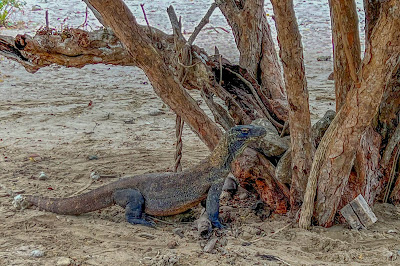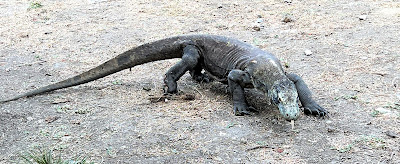I did a previous post on Rinca Island which is near Komodo Island and part of Komodo NP. That post talks somewhat about the Komodo dragon and Komodo NP. It appears that there are only a few places that visitors can visit on Komodo Island: the Loh Liang Ranger Station, Pink Beach for snorkeling, and Kampung Komodo, the main village on the island where some limited lodging is available. I believe the other red marked areas on the map below are diving areas.
We visited in the morning and were some of the first visitors. As we took a small boat to the dock we could see a Komodo dragon on the beach.
We hurried up to see it and it started to head inland. Vincent, our guide, hurried up and got our NP ranger, we had to be with, and we found the dragon we'd seen on the beach now going through an area of buildings. It was a young male, probably about six feet long.
Then we started following it down a trail and walked slowly behind it for quite a while. The NP guide placed our iPhones on the trail in front of the dragon and got some fun video of us following behind the dragon. Note a large group behind us, waiting their turn to see the dragon we were following.
We eventually went ahead and let the group behind us take a turn following the dragon. We walked through a forested area and the ranger showed us a large mound which was used by dragons to deposit eggs.
We saw several banded pigs, also known as the Indonesian wild boar. They are a food source for the dragons.
We also saw a number of orange-footed scrubfowl, also known as orange-footed megapode. They were too far away for cell phone photos and moved to fast for my camera on manual focus. I've got a very blurry photo below.
We took a walk up a small hill and got a good view of Liang Bay. As we started down the trail our ranger spotted a large dragon just a bit off the trail resting beneath a small tree. He estimated it at 20 years old.
The video below has migrated in my post to this position and rather than fight it I'm incorporating it in. The video is of an old dragon, estimated by our guide at 20 years old, walking along on an injured front foot, likely injured in battle years ago. We saw it shortly after seeing the dragon on the beach below.
We heard a squawk and a yellow-crested cockatoo was on the dead branch of a large tree near us. I got a poor, blurry photo. I found out later that this cockatoo is critically endangered and there are only about 2,500 of them that exist in the wild, with Komodo Island being the largest population.
We went further and the ranger showed us a large hole in the bank of a dry river that the ranger had seen a dragon go in the day before, he believed to lay eggs. Then the ranger rushed ahead and said to hurry. Two dragons were mating, surrounded by people taking photos. They were slowly making their way away from the beach and into the forest. I thought the female on the bottom was doing the moving, but our guide Vincett said it was the male on top doing the pushing to get away from all of the people. He said this mating can go on for two or three hours.
Then we saw another dragon a short distance away near a tree at the edge of the beach. We watched it awhile.
Then a short distance away we saw a very large dragon, estimated by the ranger at 20 years old, walking on a bum front leg, likely injured in battle. [See the video above that migrated away from this spot.]
We walked through some buildings full of locals selling carved wood dragons and shell necklaces. I bought a six ounce Sprite that had what I wanted most: a cold drink.
We walked out on the dock and caught our small boat out to our main boat moored in the bay. We visited Pink Beach outside of the Bay and had our best snorkeling ever. Judy may have some video taken by Vincent with his underwater camera.


























































